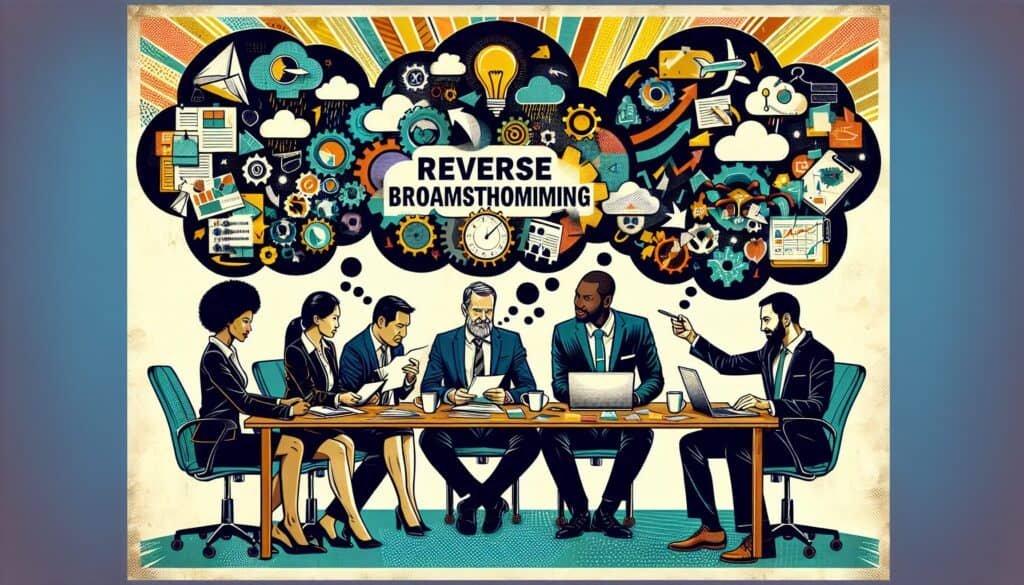Identificare potenziali problemi, punti deboli o modi in cui un piano potrebbe fallire, al fine di affrontarli in modo proattivo.
- Metodologie: Ingegneria, Qualità
Brainstorming inverso

Brainstorming inverso
- Brainstorming, Gestione del cambiamento, Miglioramento continuo, Analisi dei guasti, Innovazione, Tecniche di risoluzione dei problemi, Miglioramento dei processi, Analisi del rischio, Gestione del rischio
Obiettivo:
Come si usa:
- Invece di chiedersi "Come possiamo ottenere X?", il gruppo si chiede "Come potrebbe fallire X?" o "Come potremmo far fallire X?". I problemi identificati vengono poi utilizzati per generare soluzioni.
Professionisti
- Aiuta ad anticipare e mitigare i rischi; incoraggia il pensiero critico; può essere un buon punto di partenza per gli sforzi di miglioramento, concentrandosi su cosa evitare.
Contro
- Può talvolta portare a un'atmosfera negativa o pessimistica se non viene gestita bene; può non essere adatta a tutti i tipi di problemi; richiede la riformulazione dei problemi in soluzioni.
Categorie:
- Ideazione, Risoluzione dei problemi, Gestione del rischio
Ideale per:
- Identificare potenziali problemi o modi in cui un progetto/idea potrebbe fallire, per poi trovare soluzioni.
Reverse brainstorming is particularly effective in industries such as product design, software development, and engineering, allowing teams to proactively identify failure modes before they manifest in real-world applications. This methodology is well-suited for the early phases of project development, such as concept design and feasibility studies, where understanding potential pitfalls can inform design choices and resource allocation. Facilitators can initiate sessions with diverse teams, including engineers, designers, marketing personnel, and stakeholders, ensuring a broad range of viewpoints and expertise is represented. Participants can collaboratively brainstorm various scenarios that might lead to a product’s failure, such as design flaws, market misalignment, or inadequate user testing. The findings from these discussions can then be systematically addressed through innovative problem-solving techniques, strengthening the robustness of the product or service. Industries that have successfully implemented reverse brainstorming include automotive design, where safety and performance are paramount, and consumer electronics, where understanding user experience and preventing product recalls are crucial. This proactive approach not only enhances the likelihood of success but also nurtures a culture of continuous improvement, fostering an environment where team members feel comfortable expressing concerns and suggestions. Tools like fishbone diagrams or affinity diagrams can be utilized during these sessions to visualize problems and categorize potential failures, thereby guiding the development of targeted solutions to mitigate risks that might otherwise derail a project.
Fasi chiave di questa metodologia
- Define the objective or project.
- Formulate failure-oriented questions related to the objective.
- Brainstorm potential ways the project could fail or obstacles that could arise.
- Encourage participants to think broadly and creatively about failure scenarios.
- Prioritize and categorize the identified potential failures based on impact and likelihood.
- Analyze the prioritized failures to identify root causes.
- Develop strategies or solutions to mitigate each identified failure.
- Assign responsibilities for implementing the solutions.
- Establish metrics for monitoring the effectiveness of the solutions.
Suggerimenti per i professionisti
- Encourage team members to assume the mindset of a competitor or antagonist, enhancing the identification of potential failures from an opposing viewpoint.
- Utilize structured metrics to evaluate the identified risks and their likelihood of occurrence, ensuring prioritization of the most pressing concerns.
- Schedule follow-up sessions specifically for generating countermeasures based on the identified risks, promoting a culture of continuous improvement.
Leggere e confrontare diverse metodologie, raccomandiamo il
> Ampio archivio di metodologie <
insieme ad altre 400 metodologie.
I vostri commenti su questa metodologia o ulteriori informazioni sono benvenuti su sezione commenti qui sotto ↓ , così come tutte le idee o i link relativi all'ingegneria.
Contesto storico
1949
1950
1950
1960
1960
1960
1960
1940
1950
1950
1958
1960
1960
1960
1960
(se la data non è nota o non è rilevante, ad esempio "meccanica dei fluidi", viene fornita una stima approssimativa della sua notevole comparsa)















Post correlati
Gestione delle operazioni di produzione (MOM)
Sistema di esecuzione della produzione (MES)
Piano di controllo della produzione
Test manuali
Schede di valutazione della movimentazione manuale (MAC)
ManTRA (Strumento di valutazione dei rischi delle attività manuali)